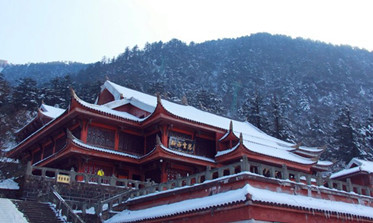Emei Mountain lies seven kilometers southwest of Emeishan City and is one of the four mountain ranges in China that Buddhists consider sacred. It was included in the UNESCO world heritage list in 1996. The mountain stretches more than 200 kilometers from south to north. Its main peak, Wanfo Top, is 3,099 meters above sea level. Since ancient times Emei Mountain has been described as "Beauty Under Heaven". Temples were built as early as the Eastern Han Dynasty (25--220) and Buddhism was introduced to the mountain during the Jin Dynasty. In the Ming and Qing dynasties there were more than 150 temples.
A legend claims that the mountain was where Samantabhadra gave lectures on Buddhism and most temples house a statue of Samantabhadra. The main scenic spots on the mountain include the Baoguo Temple, Wannian Temple, Fohu temple, Qingyin Pavilion, Heilongjiang Tunnel, Hongchun Platform, Xianfeng Temple (Jiulao Cave), Xixiang Pond and Golden Summit. These places are at different altitudes and have different climates. Temperatures at the top of mountain are 15 degrees lower than at the foot. Emei Mountain is a well-known natural museum with more than 3,000 specimens of plants and 2,000 types of animals including groups of monkeys that appear on the mountain roads and fascinate the tourists.

Baoguo Temple sits at the foot of the mountain at the entrance and exit of the mountain area. The temple was built during the reign of Ming Emperor Wanli(1573--1620). About 15 kilometers from the Baoguo Temple is Wannian Temple, one of the main temples in the mountain area. Wannian Temple, or the Temple of Samantabhadra as it was known before the Ming Dynasty, was built during the reign of Emperor Long'an of the Eastern Jin dynasty (397--401). It has no beams and houses a bronze statue of Buddha Samantabhadra mounted on a six-toothed white elephant cast in 1980, the fifth year of the Northern Song Dynasty. The statue is 7.3 meters high and weighs 62 tons. Xianfeng Temple is situated a the foot of the Jiulao Peak and the old halls were built with tin sheets and iron tiles. The intact halls were rebuilt in 1779. Fohu Temple is located one kilometer west of Baoguo Temple and at the foot of Fohu Hill. It is one of the largest temple in the mountain area. Rebuilt in 1651, it covers an area of 13,000 square meters and is accessible from the highway. At the Golden Summit, the pinnacle of the mountain area 3,065 meters above sea level, is Puguang Hall of Temple. It was constructed during the Eastern Han Dynasty and has been rebuilt several times after being struck by lightning. The Golden Summit is an ideal place to view the sunrise, the sea of clouds, the "Buddhist lights" and "Sacred lamps".
The Giant Buddha on the east bank of Mingjiang River in Leshan City, Sichuan Province, rests his feet where three rivers--the Minjiang, Qingyi and Dadu--join. The Buddha faces Emei Mountain across the river and at its back is the western slope of Lingyun Mountain. Standing at 70.7 meters with shoulders 24 meters wide it is an impressive sight. A water drainage system reduces erosion by rain and slows weathering.
The statue was begun in 713 and completed in 803. To the right of the statue a plank road with nine turns was built and it is now famous as the nine-turn plank road; it goes from the bottom to the top.












